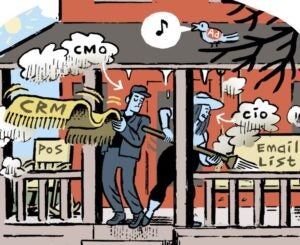 “Data-Driven Thinking” is written by members of the media community and contains fresh ideas on the digital revolution in media.
“Data-Driven Thinking” is written by members of the media community and contains fresh ideas on the digital revolution in media.
Today’s column is written by Marcus Pratt, director of insights and technology at Mediasmith.
Some estimate that a quarter or more of exchange media could be fraudulent. This has generated much discussion within the industry, with some claiming that only buyers can fix this issue, while others contend the problem sits squarely on the sell side. Naturally, the ad-tech community has been questioned, with DSPs more or less stating: “We’re working on it.”
This issue is clearly far from resolved even though nearly everyone is aware of the problem. In an ideal world, the sell side, ad-tech companies and buyers would all work towards a solution. Although we’ve seen some progress made with initiatives like the IAB’s Traffic of Good Intent, it will take time to impact the average media buy.
Buyers should not wait for the industry to sort this out. Here’s how they can take action today to reduce their exposure to fraud.
Stopping Impression Fraud Is Hard
In a AdExchanger column last year, Alex White of Peer39 appears to place the blame on advertisers for letting this fraud occur.
“Advertisers are the party paying for fraud right now, but only because they allow it,” he wrote.
White argues that advertisers should select one of several available tools offered for fraud detection. Unfortunately, it’s not quite that simple. Advertisers face many challenges when trying to combat impression fraud, particularly within RTB environments.
For example, the nature of RTB is such that, once an advertiser submits a winning bid, it becomes the owner of that impression. This means solutions must determine whether an impression is valid in a matter of milliseconds. Many solutions do not provide prevention services in an RTB environment, focusing on fraud detection. Detecting fraud can help future optimization, but it would be preferable to block it before purchasing the impression.
Ad exchanges do not currently provide rebates or clawbacks to most RTB buyers, though I agree with AdExchanger columnist Andrew Casale that they should. Intermediaries buying exchange inventory on behalf of advertisers, such as ad networks, ATDs and full-service DSPs, may offer make-goods, but since they are still on the hook to pay the exchanges, this make-good will come out of their margin. Those with slimmer margins are less likely to provide campaign refunds.
Preventing fraud at the impression level requires that solutions fully integrate with buying platforms to prevent a bid submission for fraudulent inventory. This takes time, and most fraud detection solutions are not integrated with major DSPs.
Further more, this isn’t cheap. Many solutions charge on a CPM basis, with the cost similar to third-party ad-serving. To get a rough estimate on what fraud detection might cost, look at a recent ad-serving bill. Eliminating 25% waste may be worth the cost, but it is harder to find immediate ROI on a detection-only investment.
3 Things Buyers Can Do Today
1. Develop A White List
If you are on the buy side, take look at your media plan and identify what level of transparency you have to the URL level. Direct buys with trusted media publishers may have some level of fraud, but the rates of occurrence are much lower than with long-tail exchange inventory. Buys running on opaque inventory (site list not provided) deserve deeper scrutiny.
For those offering control over where your ads will run, develop a white list of sites you feel comfortable with. There are companies that can help create these, and prior performance reports may be helpful in determining what sites to include. If evaluating domains manually, there are a few signs that a site is likely to be bot-ridden. For example, the sites that are visited almost exclusively by bots often look like they were built by bots. Look for the following:
- No “about us,” contact page or other information on who operates the site
- Lack of dates and or bylines on articles
- Content scraped from other sites
- Poor site layout
- Five or more ad slots
One example I often use is the site http://programming4.us. At first glance this site looks like a haven for computer programmers and IT professionals. On closer look, the content makes very little sense and appears to be scraped from random sections of how-to books on computing. Click one level deep and every page has 10 ads. It may not be trafficked almost exclusively by bots — though I expect it is — but even if the traffic here is human, the quality of the impressions is very low.
By running only on approved sites, using a white-list approach, advertisers can avoid unfamiliar URLs that may have bad traffic. This is far more effective than a black-list approach, where an ad is eligible to serve anywhere except the sites identified on the list. Using a black-list approach requires constant updating to keep up with the fraudsters.
2. Test A Detection Company
Consider using a third-party company to measure your current levels of suspected fraudulent activity. As noted above, the cost can be significant, but most will provide a free test and the results could be illuminating. If you have the ability to negotiate make-goods from fraudulent inventory, a detection tool could pay for itself. Before committing to a long-term agreement with a detection company, work with media vendors to update proof of performance terms and set benchmarks for campaigns. For advertisers with significant RTB budgets, look for a solution that will help with active prevention in addition to just measurement.
3. Optimize Away From The Fraud
Finally, take a look at measurement to ensure you are optimizing to the deepest metrics possible. Bots are very good at wasting impressions, they love to click on ads and will frequently visit an advertiser’s website. They do not, however, buy products. Advertisers with visibility into sales data by channel will be less likely to optimize into fraudulent inventory, while those optimizing to CTR may find more significant amounts of fraud.
A final thought for buyers sitting on the sidelines waiting for the industry to sort through these issues. As more advertisers take action to reduce purchases of fraudulent inventory, advertisers who do not change current practices could see a greater share of their impressions served to robots. The longer we wait, the worse it will get.
Follow Marcus Pratt (@mawkus), Mediasmith (@MediasmithInc) and AdExchanger (@adexchanger) on Twitter.













